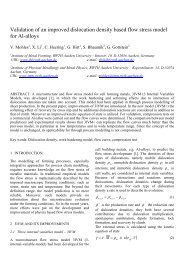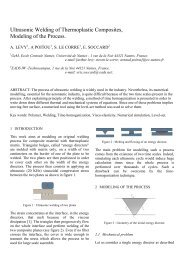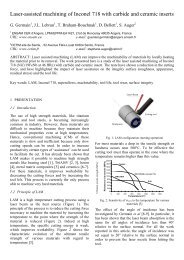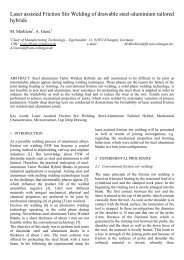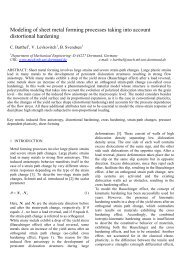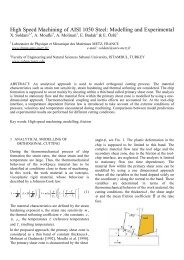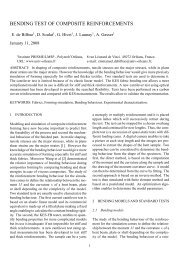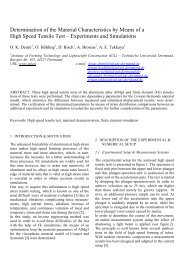Dimensional control strategy and products distortions identification
Dimensional control strategy and products distortions identification
Dimensional control strategy and products distortions identification
You also want an ePaper? Increase the reach of your titles
YUMPU automatically turns print PDFs into web optimized ePapers that Google loves.
= ε −a. Ph1− b.Ph2− c.Phi−...− n.Phnwith elementary quantities (a, b, c,..., n) of significantdisplacements <strong>and</strong> <strong>distortions</strong> phenomena ( Phi,..., Phn)(3)Experimental deviceOur coordinate measuring machine (CMM) has anindication error for length measurement defined byE=(3.5+L/350)µm, L in mm.Extension barTP20 probeStar stylusC-ringFig. 2. Experimental <strong>control</strong> devicePositioning deviceWe use a dynamic probe (TP20) with a star stylus<strong>and</strong> an extension bar (figure 2). Combined withprobe head rotations, we can access all surfaces. But,even with rotations, we do not obtain a uniformdistribution of points for the inner cylinder. We thuschecked the accuracy of our device compared with asingle TP20 probe (without extension bar <strong>and</strong> starstylus) in measuring a 44.99mm st<strong>and</strong>ard ring(table1). To succeed, we optimize the 108 points ofCMM with Tx-Ty <strong>and</strong> dilatation vectors.Table1. CMM measurements of a st<strong>and</strong>ard ring diameterValues in mm Single TP20 Our TP20 deviceDiameter 44.989 44.989Range 0.006 0.0052.2.c Processing of finite element simulationWe use Forge 2005 software to make 3D-quenchsimulations for which the input data are partlyexperimentally determined (the phase transformationkinetics, the heat transfer coefficient) <strong>and</strong> partlyfrom the literature (the mechanical data) [12].Data processing <strong>strategy</strong>For a direct comparison between experimental <strong>and</strong>simulation results, we use the method previouslypresented. For instance, this method is applied foronly the cylinders. By using “2D-cutting planes”, weexport sections’ boundary geometry at the sameheights as for CMM measured C-ring. However, wemust keep in mind that CMM measurement pointsare obtained by probing the surface following thetheoretical normals. But during simulation, nodesmove on all directions. So, we have to find theintersection point S 12 between theoretical normals T 1<strong>and</strong> finite element frontier (S 1 S 2 ).Fig. 3. Intersection point S 12 between (S 1 S 2 ) <strong>and</strong> D linesUncertainty due to the methodThe method generates a quantifiable error ε s due tothe linear approximation between two consecutivenodes of the finite element frontier (figure 3). Tominimise this error, we look for the 2 simulationpoints (S 1 <strong>and</strong> S 2 ) whose angular coordinates are asclose as possible to theoretical point (T 1 ) ones. Infigure 4, we show that higher is the sampling size;higher is the accuracy. This last also increase whenthe diameter size is smaller for the same samplingsize.Error in mm betweentheoretical <strong>and</strong>identifyed diameters0,0400,0300,0200,0100,000Evolution of diameter <strong>identification</strong> error Evolution of diameter <strong>identification</strong> e0,040Outer section0,030Inner section0,0200,0100,00082 91 121 181 362 723Number of points from a cylinder section82 91 121 181 362 723Number of points from a cylinder sectionCase 1: Simulation nodes are theoretical Case 2: Simulation nodes are theoreticalpoints of outer <strong>and</strong> inner diameters points of dilated diameters (0.5mm)Fig. 4. Uncertainty due to data processing of simulation pointsInitial geometry for quench simulationWe must take into account C-ring dilation due toheating (at 930 °C). We consider for the studiedsteel grade a linear dilatation value of 22.3 µm/m/°Cin austenitic phase. Then, we create the same meshas for experimental analysis, consisting of 98sections with 400 nodes for each cylinder’sperimeter. This fine mesh aims to minimize theuncertainty of our method.3 FIRST RESULTSA software based on the described method wasdeveloped. Thus, numerical <strong>and</strong> 3D-<strong>identification</strong> of<strong>distortions</strong> phenomena can be calculated. For abetter visual underst<strong>and</strong>ing, a scale factor is appliedon the errors onto the theoretical normals (figure 5).Theses measure errors include displacementsphenomena, like translations, rotations <strong>and</strong> offcentringof the inner diameter (due to machining).By deleting them, we did what is often called best



